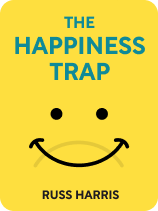

This article is an excerpt from the Shortform book guide to "The Happiness Trap" by Russ Harris. Shortform has the world's best summaries and analyses of books you should be reading.
Like this article? Sign up for a free trial here .
What is the problem with avoiding negative emotions? How do negative emotions—paradoxically enough—contribute to happiness?
Modern culture pressures us to reject negative emotions and replace them with positivity. However, even experiences that we deem positive carry with them a negative element. Therefore, we cannot really experience happiness without also experiencing potentially negative emotions.
Here is why happiness requires that you embrace negative emotions.
Don’t Run Away From Negative Emotions
Society tells us that we should seek to get rid of our mental suffering and replace it with positive feelings. This is the theme in some advertisements with a before-and-after structure. The world around a person using an inferior product is dark and gloomy. It’s only after buying the product advertised that the world becomes bright and positive. The implicit message is that you should do everything in your power to transform your dull, unhappy life into a happy one (in this case, buy a product). (Shortform note: This advertising approach is a strategy in emotional marketing, which uses color, storytelling, ideal images, and associations to trigger consumers’ emotions that motivate them to act in certain ways. Research shows that a consumer’s emotional response to an ad is two to three times more influential than the ad’s content in swaying their decision to buy the product.)
However, if we consider the problem more deeply, it becomes clear that even experiences that we regard as positive carry with them a negative counterpart.
For instance, many people consider having a child to be one of the highest forms of happiness. But having a child is a positive experience that has many potentially negative feelings associated with it, such as the stress of sleepless nights when your child is an infant, the fear that your child won’t be accepted by her peers, and anger when your child is a disobedient teenager. The positive experience can’t exist without its negative counterparts. Therefore, we cannot achieve our deepest happiness without embracing negative emotions.
Embracing Negativity
Although society pressures us to reject negative feelings, accepting all of your feelings can enhance self-esteem. When we separate self-esteem from the experience of positive feelings, we free ourselves from the myth that we’re defective if we’re not happy, and we release ourselves from the (futile) task of trying to eliminate our negative feelings. This allows us to value ourselves as we are—negative feelings and all—rather than as we’d like to be (people who don’t experience negative emotions).
Furthermore, humans vary on the scale of dispositional negativity, or the degree to which we experience negative emotions relative to context. For instance, someone with high dispositional negativity may get cut off in traffic in the morning and still be thinking about the experience later that night. Someone with low dispositional negativity could experience the same thing and recover five minutes later. In addition, people with high dispositional negativity can experience negative emotion even if there is no appropriate context for that emotion—for example, they can feel down even when there’s no apparent reason.
Instead of suggesting that people with high dispositional negativity simply think happier thoughts, or eliminate their negative feelings, psychologists recommend that they accept their negative thoughts and feelings without judgment.

———End of Preview———
Like what you just read? Read the rest of the world's best book summary and analysis of Russ Harris's "The Happiness Trap" at Shortform .
Here's what you'll find in our full The Happiness Trap summary :
- Why trying to be happy is making you unhappy
- How to practice ACT, or Acceptance and Commitment Therapy, to become happier
- How to develop “psychological flexibility” toward negative feelings instead of eliminating them






